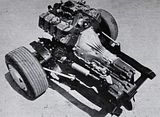In 1969, Ford built a single prototype for a mid-engined version of the Boss 429 Mustang. Built by Ford Motor Company’s Special Vehicles unit and its private Detroit-area skunkworks, Kar Kraft, this fascinating 1969 project was known internally as the LID Mustang. LID was short for Low Investment Drivetrain—a mid-engine configuration done on the cheap, using as many off-the-shelf components as possible. One notorious issue with the production Boss 429 Mustang of 1969-1970 (1,358 examples built) was its poor weight distribution, the result of cramming a big, iron hemi V8 between the front wheels of a lightweight Mustang coupe. The LID concept addressed this problem by relocating the engine from the front to the rear. Here’s how the deed was done. A standard Boss 429 engine and C6 automatic transmission were turned around backward and installed in a removable rear subframe, with the engine centered directly over the rear axle centerline. A custom-built transfer case turned the output 180 degrees and fed it to a 9-inch Ford rear axle, which was converted to independent operation with articulated half shafts and u-joints. A special axle housing incorporated an engine mount and pickup points for the Koni coilover shocks and rear control arms. The modular, drop-out layout was obviously devised with low-volume production in mind. On the outside, the LID Mustang looked much like a standard 1969 Mach I Sportsroof, with little to give away the revised engine location. The stamped steel wheels, eight inches wide at the rear and six inches in the front, were reverse offset (in front-wheel drive fashion) to preserve the stock track width, then disguised with full wheel covers borrowed from a Lincoln. The rear seat was removed and the area trimmed with black carpeting, while up front, the former engine compartment housed the battery, radiator, and air-conditioning condenser, with electric fans to provide cooling. For access to the big V8 out back, the rear glass was replaced with a Sports Slat rear louver assembly mounted on hinges and folding struts. The LID project was a complete success in this way: The Boss 429’s weight distribution was changed from 60/40 percent front to 40/60 rear. But to the engineers’ surprise, except for a reduction of wheelspin, there was no significant improvement in performance. With that discovery, the LID Mustang program was stopped in its tracks. So what was the fate of the lone mid-engine Boss 429? According to a short article on the beast in the December 1970 issue of Motor Trend, at that point it was awaiting its appointment with the crusher at a Detroit-area salvage yard. Since the unique Mustang hasn’t been seen since, we presume that’s where this story ends. |
|





